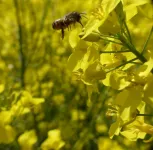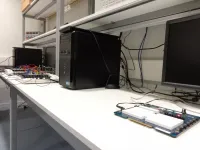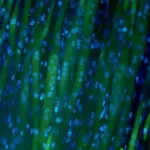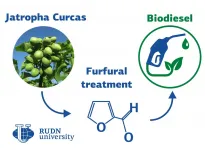(Press-News.org) In a new publication from Opto-Electronic Advances; DOI 10.29026/oea.2021.210040, Researchers led by Professor Daewook Kim from The University of Arizona, Tucson, AZ, USA consider advances in optical engineering for future telescopes.
Astronomical advances are largely coupled with technological improvements - from the invention of the first optical telescope used by Galileo in 1609 and for the foreseeable future, astronomy and optical engineering will be forever linked. This paper summarizes several advances that will enable future telescopes to expand scientific understanding of the universe. Significant optical engineering advances at the University of Arizona are being made for design, fabrication, and construction of next generation astronomical telescopes. This paper focuses on the technological advances in four key areas:
Optical fabrication techniques used for constructing next-generation telescope mirrors.
Advances in ground-based telescope alignment control and instrumentation, including laser truss-based active alignment of the Large Binocular Telescope (LBT) prime focus camera and the MOBIUS (Mask-Oriented Breadboard Implementation for Unscrambling Spectra) cross-dispersion spectroscopy unit used at the prime focal plane of the LBT.
Topological pupil segment optimization.
Future space telescope concepts and enabling technologies. Namely, the Nautilus space observatory requires precise alignment of segmented, multi-order diffractive optical elements. The OASIS (Orbiting Astronomical Satellite for Investigating Stellar Systems) terahertz space telescope presents unique challenges for characterizing the sag of the inflatable primary mirror. The Hyperion space telescope pushes the limits of high spectral resolution, far-UV spectroscopy. The CDEEP (Coronagraphic Debris and Exoplanet Exploring Pioneer) is a SmallSat mission concept for high-contrast imaging of circumstellar disks and exoplanets using a vector vortex coronagraph. These advances in optical engineering technologies will help mankind to survey, explore, and understand the scientific beauty of our universe.
A diverse selection of ground-based and space-based future telescope technologies are actively being conceptualized, designed, prototyped, and demonstrated at the University of Arizona. Associate Professor Daewook Kim has been leading the Large Optics Fabrication and Testing (LOFT) group of researchers, who investigate freeform optical system design, highly-aspheric optical surface figure manufacturing challenges, and dynamic metrology system developments. Professor Kim and his LOFT peers have published more than 150 publications as of 2021.
Computer Controlled Optical Surfacing (CCOS) process enhancements by the LOFT group enable efficient production of future optical elements. New engineering technologies will upgrade and expand the capabilities of existing large ground-based or space-based telescopes. This suite of optical technologies serves the next generation of astronomical investigations by offering novel and practical approaches that the wider design and engineering community will benefit from. It is Professor Kim's hope that these contributions in design and instrumentation will not only provide new benchmarks for modern astronomy but will also precipitate the next great insights and questions about our universe.
Professor Kim continues to coordinate with various flagship ground-based and space-based telescope missions using existing infrastructure and is working in close collaboration with the facilities' directors, staff, and scientists. He considers it essential to maintain the LOFT group's international contribution and academic service to the optics community for the next generation of advanced optical system design, manufacturing/testing, and engineering by continuously researching, developing, and applying innovative and advanced optical technologies.
INFORMATION:
Article reference: Kim DW, Choi H, Brendel T, Quach H, Esparza M et al. Advances in Optical Engineering for Future Telescopes. Opto-Electron Adv 4, 210040 (2021). doi: 10.29026/oea.2021.210040
Keywords: computer controlled optical surfacing; CCOS multiplexing / dwell time optimization / optical metrology / telescope alignment / large binocular telescope / MOBIUS / pupil segmentation / OASIS / nautilus / hyperion / CDEEP / vector vortex coronagraph
The Large Optics Fabrication and Testing (LOFT) research group led by Professor Daewook Kim consists of research faculty, post-doctoral fellows, and students dedicated to developing advanced technologies for optical design, testing, and fabrication of optical components and systems. The LOFT group's research is closely tied to hardware projects at the Optical Engineering and Fabrication Facility (OEFF) at the Wyant College of Optical Sciences and the Richard F. Caris Mirror Lab (RFCML). The intersection of basic research and production-driven projects provides LOFT faculty and students the ability to efficiently develop technical solutions from concept, to prototype, to full-scale implementation. The implementation of advanced technologies enables OEFF and RFCML to build new classes of optical components and systems. LOFT students and faculty make significant contributions to next generation astronomical telescopes such as Giant Magellan Telescope and advanced ground-based and space-based optical instruments including the ASPERA UV space telescope mission selected by NASA in 2021.
The LOFT group's research vision is strongly aligned with the future technology roadmap of collaborating faculties, the Wyant College of Optical Sciences, the Department of Astronomy, the Lunar and Planetary Laboratory, the Large Binocular Telescope Organization, and the two large optics fabrication facilities, OEFF and RFCML, at the University of Arizona. High-profile astronomical optical systems require cutting-edge optical engineering technologies and provide extensive opportunities to establish high-quality research projects.
Opto-Electronic Advances (OEA) is a high-impact, open access, peer reviewed monthly SCI journal with an impact factor of 9.636 (Journals Citation Reports for IF 2020). Since its launch in March 2018, OEA has been indexed in SCI, EI, Scopus, CA and ICI databases over the time and expanded its Editorial Board to 33 members from 17 countries and regions (average h-index 46).
The journal is published by The Institute of Optics and Electronics, Chinese Academy of Sciences, aiming at providing a platform for researchers, academicians, professionals, practitioners, and students to impart and share knowledge in the form of high quality empirical and theoretical research papers covering the topics of optics, photonics and optoelectronics.
More information: http://www.oejournal.org/oea
Editorial Board: http://www.oejournal.org/oea/editorialboard/list
All issues available in the online archive (http://www.oejournal.org/oea/archive).
Submissions to OEA may be made using ScholarOne (https://mc03.manuscriptcentral.com/oea).
ISSN: 2096-4579
CN: 51-1781/TN
Contact Us: oea@ioe.ac.cn
Twitter: @OptoElectronAdv (https://twitter.com/OptoElectronAdv?lang=en)
WeChat: OE_Journal
BLOOMINGTON, Ind. -- Scientists at Indiana University have found that significant amounts of the two main components of cannabis, THC and CBD, enter the embryonic brain of mice in utero and impair the mice's ability as adults to respond to fluoxetine, a drug commonly used to treat anxiety and depression and known by the brand name Prozac.
The study suggests that when the developing brain is exposed to THC or CBD, normal interactions between endocannabinoid and serotonin signaling may be diminished as they become adults.
"Hemp-derived CBD is a legal substance in the U.S., and we are in a time of increasing state-level legalization of cannabis. ...
A team of researchers from the University of Cambridge, University College London, University of Oxford, and University of Brescia/RFF-CMCC European Institute on Economics and the Environment carried out the first systematic analysis of the relative performance of probabilistic cost forecasts from expert-based methods and model-based methods.
They specifically focused on one expert-based method -- expert elicitations -- and four model-based methods which model costs either as a function of cumulative installed capacity or as a function of time. The results of this ...
Researchers have developed a more efficient platform for studying proteins that play a key role in regulating gene expression. The approach uses engineered yeast cells to produce enzyme and histone proteins, conduct biochemical assays internally, and then display the results.
"Biomedical and biotech researchers are interested in the mechanisms that allow histones to regulate gene activity," says Alison Waldman, first author of a paper on the work and a Ph.D. student at North Carolina State University. "But the conventional tools for histone research are unwieldy ...
Mass-flowering crops such as oilseed rape or faba bean (also known as broad bean) provide valuable sources of food for bees, which, in turn, contribute to the pollination of both the crops and nearby wild plants when they visit. But not every arable crop that produces flowers is visited by the same bees. A team from the University of Göttingen and the Julius Kühn Institute (JKI) in Braunschweig has investigated how the habitat diversity of the agricultural landscape and the cultivation of different mass-flowering crops affect wild bees. The research shows that diverse agricultural landscapes increase the species richness ...
A team led by Skoltech professor Artem R. Oganov studied the structure and properties of ternary hydrides of lanthanum and yttrium and showed that alloying is an effective strategy for stabilizing otherwise unstable phases YH10 and LaH6, expected to be high-temperature superconductors. The research was published in the journal Materials Today.
Cuprates had long remained record-setters for high-temperature superconductivity until H3S was predicted in 2014. This unusual sulfur hydride was estimated to have high-temperature superconductivity at 191-204 K and was later obtained experimentally, setting a new record in superconductivity.
Following this discovery, many scientists turned to superhydrides, which are abnormally rich in hydrogen, and discovered new compounds that ...
Laboratories are an inherent part of technology qualifications, as practical experiments are essential for students to acquire the competencies and skills that they will need during their future professional development. Providing this learning in a virtual format is one of the challenges posed by the current COVID-19 pandemic--a challenge that distance universities have been addressing for years. RLAB-UOC is a remote laboratory designed and developed by the Universitat Oberta de Catalunya (UOC) that enables students in the Faculty of Computer Science, Multimedia and Telecommunications to conduct practical experiments with real electronic and communications equipment anywhere, at any time. A new article published in the scientific journal Electronics has described the characteristics ...
Near-death experiences are known from all parts of the world, various times and numerous cultural backgrounds. This universality suggests they may have a biological origin and purpose, but exactly what this could be has been largely unexplored.
A new study conducted jointly by the University of Copenhagen (Denmark) and the University of Liege (Belgium) and published in Brain Communications shows how near-death experiences in humans may have arisen from evolutionary mechanisms.
"Adhering to a preregistered protocol, we investigated the hypothesis that thanatosis is the evolutionary origin of near-death experiences", says Daniel Kondziella, a neurologist from Rigshospitalet, Copenhagen University Hospital.
When attacked by a predator, as a last resort defense mechanism, ...
An affordable lab system that uses grass blades to turn cells into cultured meat has been developed at the University of Bath in the UK.
Researchers have successfully taken grass from the university's campus and used it to create a scaffold that animal cells can attach to and grow on. The resulting tissue has the potential to be used both as lab-made meat and as human muscle tissue to repair or replace tissue which has been damaged or lost through injury or disease.
The study, by Dr Paul De Bank (Department of Pharmacy & Pharmacology), Professor Marianne Ellis (Department of Chemical Engineering) and Scott Allan (a PhD researcher in the Department of Chemical Engineering), is published in this month's Journal of ...
RUDN University chemists have proposed a new method of producing fuel from Jatropha Curcas, a poisonous tropical plant. Natural minerals and a non-toxic additive from vegetable raw materials are used for that. The reaction efficiency is 85%. The fuel can be used in diesel internal combustion engines. The results are published in the International Journal of Green Energy.
Jatropha Curcas is a common plant in many tropical regions. Its seeds contain lots of oil, but they cannot be used agriculture because the oil contains toxins that are dangerous for people and animals. But the composition of jatropha oil is suitable for the manufacture of biodiesel. One of challenge of the processing the plant raw materials is to select sufficiently ...
PROVIDENCE, R.I. [Brown University] -- Researchers from Brown University and MIT have developed a new data science framework that allows users to process data with the programming language Python -- without paying the "performance tax" normally associated with a user-friendly language.
The new framework, called Tuplex, is able to process data queries written in Python up to 90 times faster than industry-standard data systems like Apache Spark or Dask. The research team unveiled the system in research presented at SIGMOD 2021, a premier data processing conference, and have made the software freely available to all.
"Python is the primary programming language used by people doing data science," said Malte Schwarzkopf, an assistant professor of computer ...




